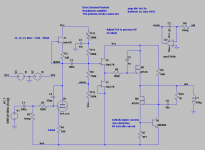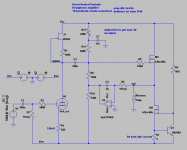Fixed for now
So I fixed a few things.
a) moved the servo connection to a different point and redid the jfet stage bias
b) changed servo capacitor from 10uF to 1uF
c) removed the jfet source resistor from J3 because it introduced a lot of distortion
There are no oscillations now when the servo loop is in. The output DC offset stays at below 20mV. Note that it takes approximately 20 seconds for the output DC offset to get below 20mV, which can damage the headphones. Ideally the headphones should be connected after about 20 seconds. I might implement a simple relay based delay to keep the output disconnected for a short time upon power-up.
Edit: connected a 47R resistor at the output and then ran a 1kHz sine wave in, so that the output would be at normal listening levels. Then measured the harmonic distortion at the output using the HP 3585A spectrum analyzer. The fundamental measured at 111mV, the second harmonic at 160uV, and the third harmonic at 20uV. We can normalize these numbers by dividing the second and third harmonic values by the fundamental to get 144e-05 and 180e-06. Compare this to the normalized distortion numbers of post 77 which are 3.78e-05 and 1.33e-06. How's that for difference between simulation and reality?
Edit2: the servo opamp seems to pass about 10mA to Vee, and it gets warm, almost host. Sticking a tiny heatsink on it brought the output DC offset below 10mV and the opamp is definitely happier.
So I fixed a few things.
a) moved the servo connection to a different point and redid the jfet stage bias
b) changed servo capacitor from 10uF to 1uF
c) removed the jfet source resistor from J3 because it introduced a lot of distortion
There are no oscillations now when the servo loop is in. The output DC offset stays at below 20mV. Note that it takes approximately 20 seconds for the output DC offset to get below 20mV, which can damage the headphones. Ideally the headphones should be connected after about 20 seconds. I might implement a simple relay based delay to keep the output disconnected for a short time upon power-up.
Edit: connected a 47R resistor at the output and then ran a 1kHz sine wave in, so that the output would be at normal listening levels. Then measured the harmonic distortion at the output using the HP 3585A spectrum analyzer. The fundamental measured at 111mV, the second harmonic at 160uV, and the third harmonic at 20uV. We can normalize these numbers by dividing the second and third harmonic values by the fundamental to get 144e-05 and 180e-06. Compare this to the normalized distortion numbers of post 77 which are 3.78e-05 and 1.33e-06. How's that for difference between simulation and reality?
Edit2: the servo opamp seems to pass about 10mA to Vee, and it gets warm, almost host. Sticking a tiny heatsink on it brought the output DC offset below 10mV and the opamp is definitely happier.
Attachments
And an update. Wavebourne asked me: "why do you need that jfet source-follower?" And though it seemed like I couldn't get the circuit working with low distortion before without the jfet source-follower, I tried again. And not only it works, but it works better. Even got rid of all compensation capacitors, and it's stable and it rocks. This version is also easier to build.
As active load I've tried the simple CCS with a BF862 and also with a 2SK170. I'll probably stay with the BF862 because of its lower capacitance. I've also tried a simple gyrator made with an MPSA81.
As active load I've tried the simple CCS with a BF862 and also with a 2SK170. I'll probably stay with the BF862 because of its lower capacitance. I've also tried a simple gyrator made with an MPSA81.
Attachments
Member
Joined 2009
Paid Member
I think it would be worth spending a little bit on some output transformers and at least try the DHT without any FETs in the signal path. Just the triode. I think this was suggested by Sheldon already - I just thought I'd add my vote
I might have suggested that, but it would have been a while ago. But I like to see people get creative with hybrid designs too. One advantage of the present approach is very good PSRR. Planning on battery power for the filament?
Sheldon
Last edited:
Bigun, when I come across some cheap output transformers I will try that. Until them, I'll have to do with this.
Sheldon, I was thinking of some variation of Rod Coleman's filament supply, gyro+ccs. For Vcc/Vee I'll be using some variant of my shunt regulator.
The prototype works and is solid, distortion seems decently low (on a spectrum analyzer), so I'm working on a pcb for this project.
Sheldon, I was thinking of some variation of Rod Coleman's filament supply, gyro+ccs. For Vcc/Vee I'll be using some variant of my shunt regulator.
The prototype works and is solid, distortion seems decently low (on a spectrum analyzer), so I'm working on a pcb for this project.
Bigun, when I come across some cheap output transformers I will try that. Until them, I'll have to do with this.
Sheldon, I was thinking of some variation of Rod Coleman's filament supply, gyro+ccs. For Vcc/Vee I'll be using some variant of my shunt regulator.
The prototype works and is solid, distortion seems decently low (on a spectrum analyzer), so I'm working on a pcb for this project.
Are you finding the Coleman filament supply to be quiet enough for low ohm high efficiency phones like Grados?
Member
Joined 2009
Paid Member
Bigun, when I come across some cheap output transformers I will try that. Until them, I'll have to do with this.
I hope you might be getting such a nice sound from this amp that you won't have any use for transformers
But if you get curious you could try just one channel, then you buy only one transformer. You could look on fleaBay for some 'deals'.
Also, this may be of interest:
Budget OPT's
p.s. A Hammond 125CSE is $39 new from Angela Instruments (as of today)
Last edited:
I don't have Grados but I'll let you know how it works with my 106 db/mW Sony mdr-v6, when it's finished.
Any news? I'm holding off building my next amp on your report. If coleman's DC Heater doesn''t hum with headphones I am going to try DHTs.
I personally really like what you are doing with the hybrid design, the "ideal" transformer is none and I think SS can come closer to that ideal than 20th century iron
The power supply isn't built yet. You shouldn't wait for me, my progress isn't exactly fast.
Ha Ha, I'll bet I'm slower than you. Thanks for the kick in the A$$
Do keep us updated though as very few of us are investingating a hum free DHT for headphones.
Ha Ha, I'll bet I'm slower than you. Thanks for the kick in the A$$
Do keep us updated though as very few of us are investingating a hum free DHT for headphones.
Hello,
Speaking of a power supply for a DHT triode.
Pete Millet has built some pretty nice headphone amplifiers. If you look at his website he has a recurring theme in his work and now has for sale a PCB for a heater regulator.
Regulated DC filament supply
I bought a pair to try with a pair of DHT 307A’s. Just a thought.
DT
All just for fun!
This topic keeps on getting resurrected so I feel compelled to give an update. Finished the 1S4 amp, and tested it out. For the prototype I use a regulated lab power supply, which worked well. To keep it simple I also use a filament supply based on a LM317 CCS. As soon it got it`s own non regulated psu, with two chunky Siemens 47mF caps, there was hum in the headphones. It`s not hard to see that the psrr of this circuit is really low, and outstanding filtering or regulation is a must. Why hum? Well, the total current drawn from the power supply was about 800mA. The price of class-A.h
One other thing I noticed. The littlest touch of the tubes will give a long tune. So that`s what microphonics is all about...
DT, thanks for the pointer. It's pretty much what I used in the prototype, except that I had the LM317 on hand. I also have another prototype using a different type of basic CCS based on a mosfet+bjt. That seemed to be more promising. When finished, I'll post it.
One other thing I noticed. The littlest touch of the tubes will give a long tune. So that`s what microphonics is all about...
DT, thanks for the pointer. It's pretty much what I used in the prototype, except that I had the LM317 on hand. I also have another prototype using a different type of basic CCS based on a mosfet+bjt. That seemed to be more promising. When finished, I'll post it.
Hello ikoflexer,
Thanks for the update. I have not yet listened to a DHT head phone amplifier. I have built several versions of IHT. All with regulated B+ supplies. I prefer the sound of the transformer output versions. I do not know if it has anything to do with the capacitor in the output of the OTL version or not.
How does you DHT sound when it is not ringing or huming?
DT
All just for fun!
Thanks for the update. I have not yet listened to a DHT head phone amplifier. I have built several versions of IHT. All with regulated B+ supplies. I prefer the sound of the transformer output versions. I do not know if it has anything to do with the capacitor in the output of the OTL version or not.
How does you DHT sound when it is not ringing or huming?
DT
All just for fun!
I've been so happy with my one tube (6s45p) headphone amp that it's hard to find the motivation to work on this one. So, I'm afraid, no progress here.
Iko this is very ironic, is this the hybrid? I build a WE417 SE OPT spud headphone amp with dual Salas regs and compared to commercial DHT headamps I lost my motivation to persue another attempt at DIY DHT. Its that good.
The 6S45P/WE417/5842/D3A Spud SE OPT headphone amps seem to be the kings of tube headphone amplifiers for quite a few objective listeners.
- Status
- This old topic is closed. If you want to reopen this topic, contact a moderator using the "Report Post" button.
- Home
- Amplifiers
- Headphone Systems
- Class A, DHT driven, headphone amp

